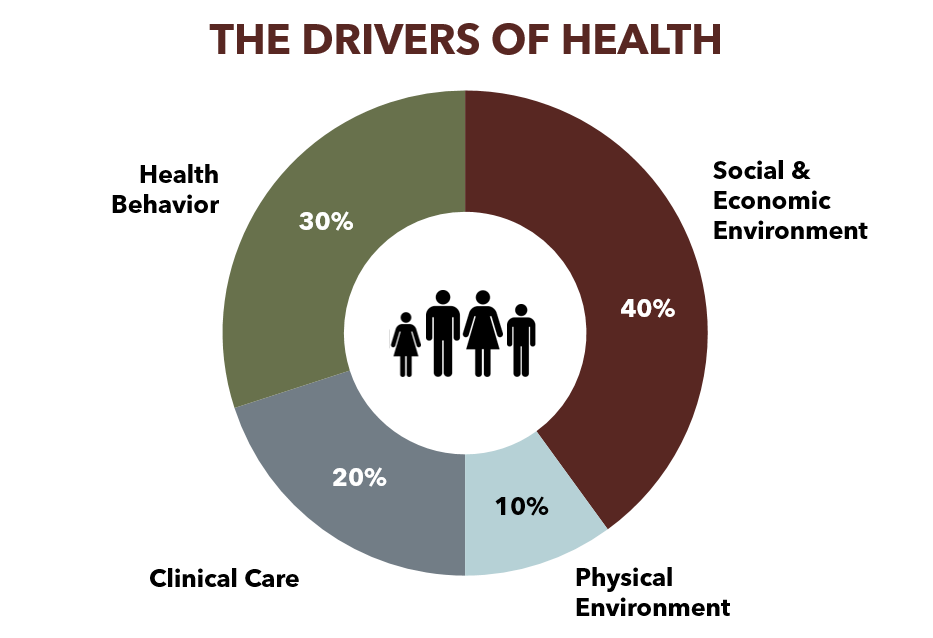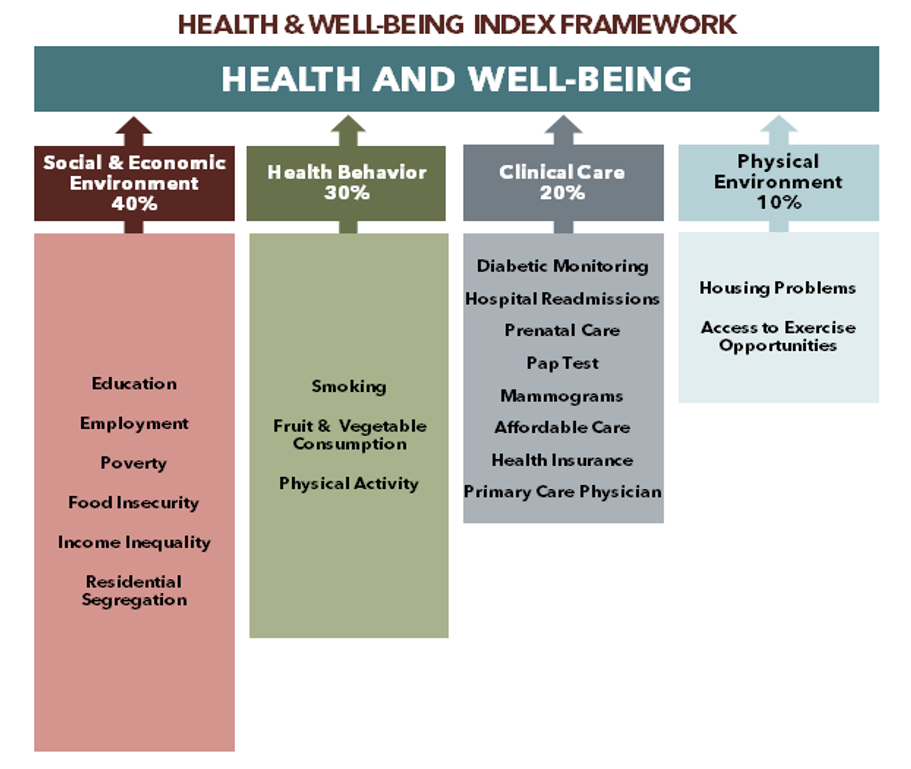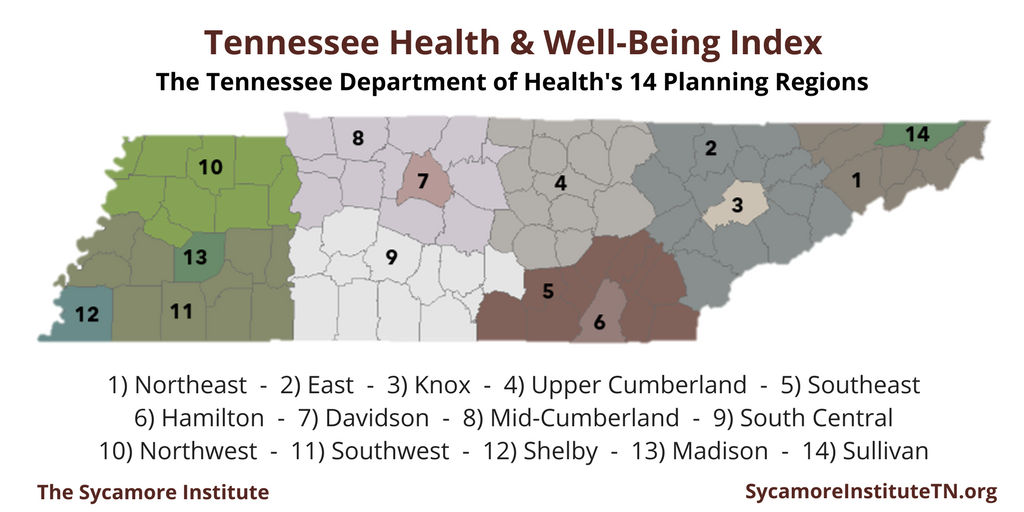Tennessee Health & Well-Being Index
Tracking the drivers of Tennesseans’ health
Archive
 What Are Health and Well-Being?
What Are Health and Well-Being?
The World Health Organization defines health as “a state of complete, physical, mental, and social well-being and not merely the absence of disease or infirmity.” While there is no single definition for well-being, all definitions of well-being are based on “judging life positively and feeling good.” Well-being couples the absence of disease with a lack of stress and a feeling of hopefulness.
What Influences Health?
Health means more than just health care. While access to clinical care is a contributing factor, our behaviors and the physical, social, and economic environments in which we live, work, and play are also major drivers of health. To better understand what influences the health of Tennesseans, we must consider people’s lives in a larger context.
How Is the Health & Well-Being Index Score Calculated?
The Index score is a calculation of 24 metrics within 4 domains that represent the 4 drivers of health.
- Social & Economic Environment Domain
- Health Behavior Domain
- Clinical Care Domain
- Physical Environment Domain
Each metric is compiled using data that are publicly available at both the state and regional or county level. The 4 domain scores are weighted based on their relative contributions to health. Scores are on a scale from 0 to 10. Higher scores indicate better performance. Compared to a score of 6.5, a score of 7.0 indicates a better job is being done to address the drivers of health and better health outcomes are expected.
The 4 Domains of the Tennessee Health & Well-Being Index

Social & Economic Environment
Our social and economic environments encompass where we live, work, and play. Influencing health and well-being more than any other domain, these factors include access to a quality education, job opportunities, safe neighborhoods, social support, and healthy foods. In fact, education and income are the greatest predictors of health. Individuals with higher levels of education and income live longer and are healthier. This relationship exists at both the individual and community level. People who live in wealthy, highly-educated communities are more likely to be in better health and live longer than those who do not.
Health Behavior
A person’s health behavior has a large impact on the length and quality of their life. Smoking, physical activity, and diet are highly significant health behaviors. These three health behaviors are associated with a person’s risk for developing many chronic illnesses such as diabetes, cardiovascular disease, cancer, and obesity. Modifications in these three areas can bring about great changes in health outcomes and quality of life. While health behaviors are a personal choice, a person’s environment can encourage or discourage healthy behaviors.
Clinical Care
Clinical care refers to any interaction with the health care system, ranging from preventive activities like vaccines and screenings to the treatment of particular diseases and conditions. Clinical care takes place in a variety of settings such as outpatient clinics, hospitals, public health departments, and long-term care facilities. Effective health care is accessible, affordable, timely, and high quality.
Physical Environment
The physical environment includes the natural environment, transportation systems, buildings, and public resources. A person’s school, work, and home environment influences their health behaviors and has a direct impact on their health. For example, access to sidewalks, parks and playgrounds offer opportunities for physical activity, while exposure to pollution or unsafe drinking water contributes to health conditions like asthma and waterborne illness.
Regions of Tennessee
The Tennessee Health & Well-Being Index tracks the drivers of health statewide and within the Tennessee Department of Health’s 14 planning regions (shown in this map). The counties in each region are listed below.

1) NORTHEAST REGION: Carter, Greene, Hancock, Hawkins, Johnson, Unicoi & Washington Counties
2) EAST REGION: Anderson, Blount, Campbell, Claiborne, Cocke, Grainger, Hamblen, Jefferson, Loudon, Monroe, Morgan, Roane, Scott, Sevier & Union Counties
3) KNOX REGION: Knox County
4) UPPER CUMBERLAND REGION: Cannon, Clay, Cumberland, Dekalb, Fentress, Jackson, Macon, Overton, Pickett, Putnam, Smith, Van Buren, Warren & White Counties
5) SOUTHEAST REGION: Bledsoe, Bradley, Franklin, Grundy, Marion, McMinn, Meigs, Polk, Rhea & Sequatchie Counties
6) HAMILTON REGION: Hamilton County
7) DAVIDSON REGION: Davidson County
8) MID-CUMBERLAND REGION: Cheatham, Dickson, Houston, Humphreys, Montgomery, Robertson, Rutherford, Stewart, Sumner, Trousdale, Williamson & Wilson Counties
9) SOUTH CENTRAL REGION: Bedford, Coffee, Giles, Hickman, Lawrence, Lewis, Lincoln, Marshall, Maury, Moore, Perry & Wayne Counties
10) NORTHWEST REGION: Benton, Carroll, Crockett, Dyer, Gibson, Henry, Lake, Obion & Weakley Counties
11) SOUTHWEST REGION: Chester, Decatur, Fayette, Hardeman, Hardin, Haywood, Henderson, Lauderdale, McNairy & Tipton Counties
12) SHELBY REGION: Shelby County
13) MADISON REGION: Madison County
14) SULLIVAN REGION: Sullivan County












